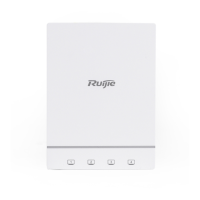Configuration Guide Configuring FAT APs
Configuring the Minimum Value of RSSI for STA Access
Optional.
If there are no special requirementsIf there are no special requirements, you can perform this configuration in the
dot11radio interface configuration mode of the AP equipment.
The lower the RSSI for STA access, the lower the RSSI for STAs that are allowed for access, and often the longer the
distance from STAs that are allowed for access to a FAT AP.
rssi-value: indicates the minimum RRIS for STA access, ranging from 0 to 100 in the unit of dB.
The minimum RSSI for STA access is 0, which indicates that all STAs are allowed for access regardless of
their RSSI values.
dot11radio interface configuration mode
Configuring the Minimum RSSI That Keeps STA Access
Optional.
If there are no special requirementsIf there are no special requirements, you can perform this configuration in the
dot11radio interface configuration mode of the AP equipment.
The lower the RSSI that keeps STA access, the lower the RSSI for STAs whose access can be kept, and often the
longer the distance from STAs that are allowed for access to a FAT AP.
rssi-value: indicates the minimum RRIS that keeps STA access, ranging from 0 to 100 dB.
The minimum RSSI that keeps STA access is 0, which indicates that the access of all STAs is kept
regardless of their RSSI values.
dot11radio interface configuration mode
Configuring the Transmit Power of Management Frames
Optional.
If there are no special requirementsIf there are no special requirements, you can perform this configuration in the
dot11radio interface configuration mode of the AP equipment.
The higher the transmit power (except for 0) for management frames, the larger the STA range of a FAT AP, and often
the longer the distance from STAs that are allowed for access from a FAT AP.
coverage-area-control power-value
power-value: indicates the transmit power for management frames, ranging from 0 to 32 dBm.

